108 Search Results for visual schedules
September 21, 2013
by Carole Zangari -
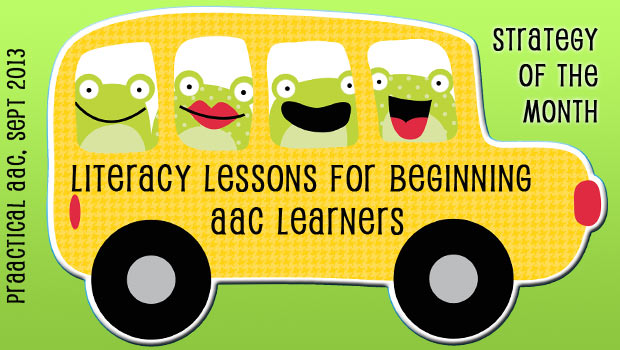
Like some of you, we are often met with skepticism when we encourage teams to work on literacy skills with individuals who are still learning the very basics of communication. Recently, we had the opportunity to begin this journey anew, and model a literacy lesson for kindergartners who have no formal communication system, are not answering yes/no questions, and do not consistently select preferred items when offered choices. Why work on literacy with students who are not routinely expressing their basic preferences? Because the longer we wait, the longer it will take to get there. Because it offers wonderful opportunities to build communication, too. Because when other people see us teaching reading and writing, it changes their perception of the student in a positive way. Because they will enjoy it. Because there are mandates for us to address the general education curriculum. Because if we set the bar high and... [Read More...]
September 12, 2013
by Robin Parker -
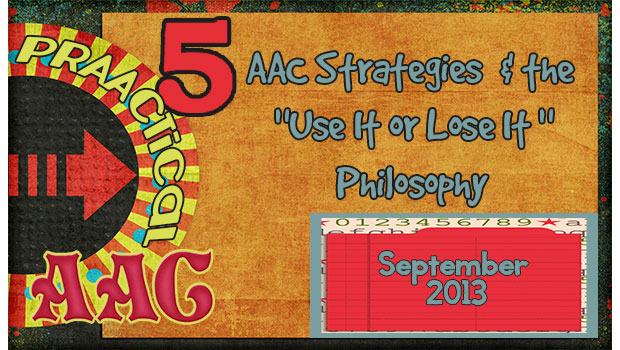
School has begun for almost everyone. Some classes have been in session for a while and routines have been formed, learning is taking place, behaviors have settled down. Now comes what can seem like the hard part: Keeping up with and expanding the strategies that helped students become successful. Instead of trying to fade AAC displays/devices and visual supports, stick with the basics and expand how they can be used. Because if you don’t use it, you may lose it. So: Keep up with: Visual Schedules– monthly, daily, and mini. Even if students know the schedule, continue to use it. Most of us would not like ‘losing’ our day planner or ‘to do’ lists even though we know our schedules. Aided Language Input First- Then Visual Support Visual Boundaries Access to a AAC Display/Device– And the display or device is with the student All the time, everywhere, charged, working, and... [Read More...]
August 5, 2013
by Robin Parker -

PrAACtical Thinking Free Text-based AAC Apps for the iPad PrAACtical Questions: Can Students Take Their AAC Device Home? PrAACtical AAC Learning & July 4th: Get Ready Get Set Go 4 Free July 4th Apps to SPARK Commenting 30 Posts You May Have Missed in June 4+AAC Tips for Talking About July 4th AFTER the Festivities PrAACtically Ready to Read Did You Know: AADMD Offers Specialty Webinars Visual Schedule Myths Live On..& On Getting to Yes Working with Worksheets Apps to Prepare, Learn, & Talk About Summer Vacations Modify a Battery-Operated Toy To Make It Accessible By Switches 5 Great Ways To Help People with AAC Needs Develop Inner Speech What’s the Connection: Core Vocabulary and Visual Schedules Random App of Kindness Giveaway: Talk About Food Create Your Own Style PECS Book 5 Things to Consider About Assigning ‘Homework’ to Your AAC Clients 8Friday Fun: 8 AAC Activities that are Fast... [Read More...]
August 3, 2013
by Carole Zangari -
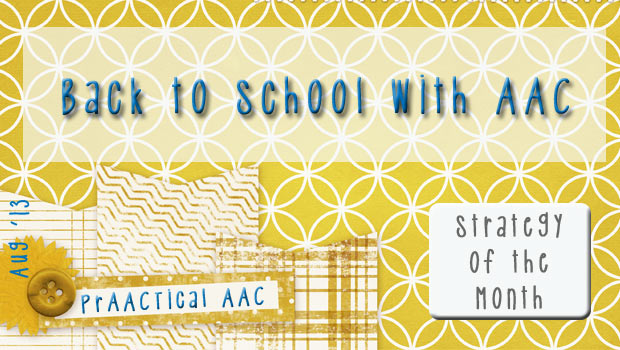
Here in the US, August is Back-to-School month. Throughout this month, we’ll try to post ideas and resources to help make the transition back to school a smooth and successful one. One of the most important things for students who use AAC is having their SLPs, teachers, and families on the same page. They each have a different but very intense relationship with the student’s AAC system. Here are some prAACtical thoughts on getting everyone on the same page. 1. Develop a communication profile of the student: In the initial weeks, try to get a baseline of how the student is communicating at the start of the year. For beginning communicators, we track things like their communicative intents (WHY they are communicating), modalities (HOW they are communicating), and the frequency of their communication. We’ve written about one of our favorite tools for this, the Communication Matrix. 2. Share what you know:... [Read More...]
February 13, 2013
by Carole Zangari -
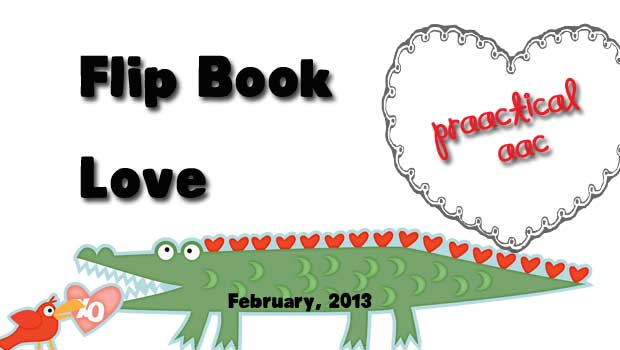
We love the versatility of flip books and charts. They are a great format option for communication books, particularly the flip books that have a static ‘base’ and a set of strips/mini pages that you can flip through for additional vocabulary. Once you have a template, it’s not too difficult to make a number of them that fit different purposes. Here are some resources to explore. SET-BC has wonderful material on communication supports including a brief video about flip books here. They also have some terrific downloads, including this one by Kathy Ryan. Flip ‘n Talk has been around for a long time, but it continues to be a really useful tool. We typically have the core language as the static portion, but here’s an example of doing it the other way around. There are so many ways to use flip books for language learning. We love this one for... [Read More...]
October 20, 2012
by Carole Zangari -
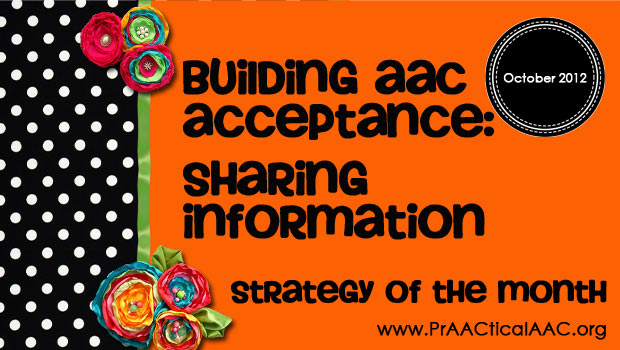
While there are certainly attitudinal barriers to AAC, it’s also true that sometimes the people we are trying to influence just need more information. Sounds simple, right? Not exactly. Especially when we consider these factors. Adult learners prefer to chart their own course to learning new things rather than have others lay that out for them. Our behaviors are most likely to change when we discover solutions for ourselves, as opposed to following directions that others give to us. We have a limited amount of time to guide others to the information they need. Here are some things that have worked for us. Develop a bank of educational materials that pertain to the topics that you face most often in your clinical work. Create resource files for general topics, such as the empirically-supported benefits of AAC, and specific topics, such as the evidence base for using SGDs with individuals who... [Read More...]
August 1, 2012
by Carole Zangari -
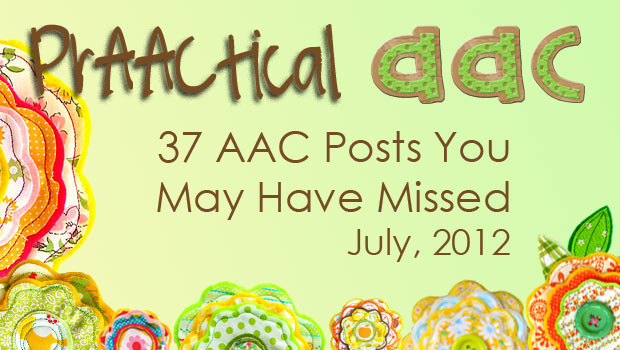
Biennial Conference: ISAAC 2012 PrAACtically There: ISAAC 2012 Day 1 at ISAAC 2012: What You Should Know About AAC’s Expanding Role in Health Care ISAAC 2012, Day 2: AAC Goes to Preschool ISAAC 2012, Day 3: Let the Games Begin ISAAC 2012, Day 4 – The Fives 5+5 Commandments for Speech Output Communication 5 Under-Used Strategies in AAC 5 Online Notebooks Full of AAC 5 Adapted Play Resources for Children with Motor Impairment – PrAACtical Thinking 92 Free or Lite Versions of AAC Apps PrAACtical Alert: Free AAC Evaluation App This Week Visualize 9 Nice Things to Say to Students who AAC PrAACtical Thoughts About Challenging Behavior PrAACtical Resource: Searching for AAC Devices with SpeechBubble AAC Assessment Round-Up 5 Ways to Use Rating Scales to Enhance Communication with AAC PrAACtical Alert: The World’s AAC Conference Comes to You (Well, a little bit of it) Power of the Visual Planner: 20... [Read More...]
July 28, 2012
by Robin Parker -
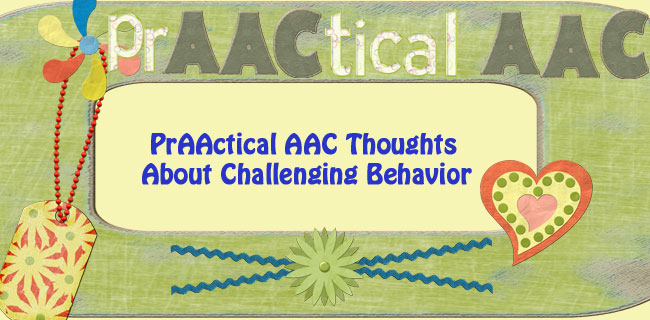
Some PrAACtical AAC thoughts about challenging behavior: I wonder if it is ok to say that we love seeing challenging behavior during speech-language therapy sessions or observations. Well, I said it, both of us do, because if we really ‘listen’ then we can figure out what to teach that will really help our students. We tend to prioritize our goals into High Priority and General Priority. Challenging behavior and the communication message behind it, definitely falls into high priority. This is because challenging behavior in students limits experiences, limits interaction, and overall limits opportunities for people to get to know you. Consider Challenging Behavior through Communication Glasses Is it really Challenging Behavior? behavior that is or can be destructive or hurtful. Examples include but are not limited to: hitting, biting, spitting, throwing, pounding, etc. (Note: we are not talking about poor eye contact or poor attention to task or even laughing... [Read More...]
July 7, 2012
by Carole Zangari -
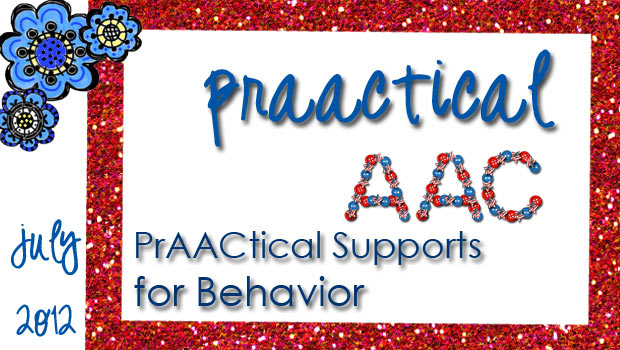
Rachel arrives to therapy tense and upset. Mauro gets frustrated when the clinician presents new activities. Brianna starts to bang the table when demands are placed on her. Zach becomes agitated when he has to wait for something he wants. – Like any set of tools and strategies, AAC works best when the communicator is relaxed, confident, and engaged. Our July Strategy of the Month focuses on PrAACtical Supports for Behavior. We hope to share ideas for planning therapy sessions that help AAC learners stay focused, calm, and engaged. — We’re big believers in the old adage that an ounce of prevention is worth a pound of cure. So, what can we do to prevent or minimize problems like the ones experienced by Rachel, Mauro, Brianna, and Zach? The answers have to do with having clear and appropriate expectations, and using visual and AAC supports effectively. When used consistently, these strategies... [Read More...]
June 1, 2012
by Robin Parker -
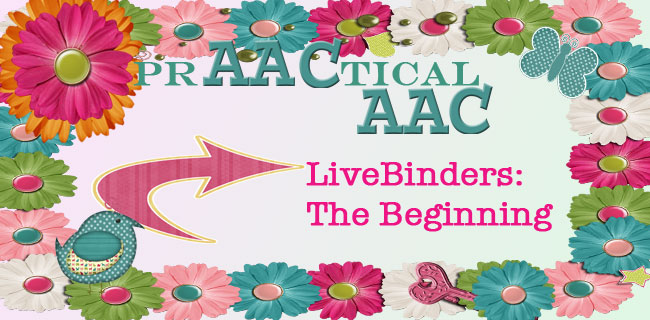
We have always started our collaborative projects with a retreat (usually a day at the beach or park). The retreat usually ends with a project and a plan to meet again. Following the retreat that inspired PrAACtical AAC, we were spending hours upon hours on the computer searching We were using pen and paper to write down urls to sites we wanted to share. We couldn’t believe the great information that was available. So when Carole told me to sit down and said “you have to look at what I found, it’s called LiveBinders“. I can still remember the exact moment. It was like on T.V….. the sun started shining through the window of my living room and music started playing. We couldn’t believe there was a site that was easy to use, would organize all the work we had done, let us look at and use other binders,... [Read More...]









